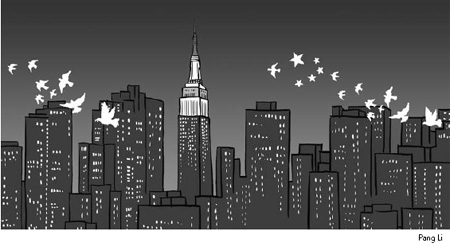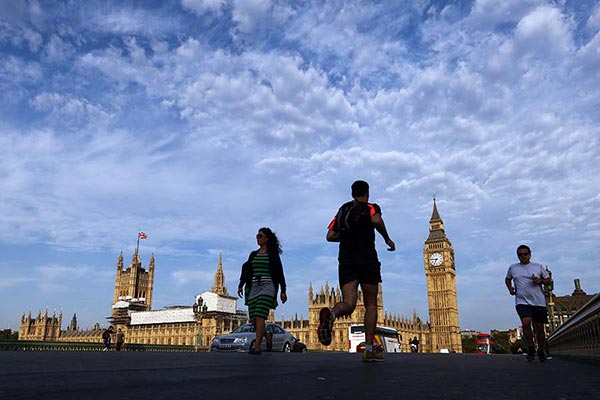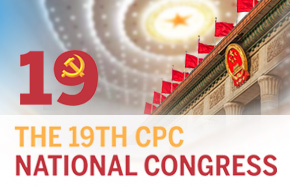New York lights a candle for China

As a native New Yorker far from home, I felt a surge of pride to see photos of the Empire State Building lit up in commemoration of the 60th anniversary of the founding of the People's Republic of China.
Casting the upper floors of New York's pride and joy in colored spotlights is nothing new; it's been done in honor of everything from St. Patrick's Day and India Day to Columbus Day and July Fourth. As a New Yorker, one gets used to that.
Some people made a fuss about it and New Yorkers are used to that, too. Of course, turning on the lights and shifting the color wheel for American traditions is one thing, doing the same in the name of friendship with a foreign power is another, especially a powerful foreign power.
It comes as no surprise that a coterie of anti-China activists registered their dismay with a little protest at the main entrance to the towering edifice. Nor does it surprise anyone that a handful of politicians jumped on the bandwagon; feigning shock that "communist" China, of all countries, should be so celebrated, or simply channeling a generalized indignation against things not American.
Sadly, there's precedent enough for casting rivals as enemies and regarding anything foreign as suspect in America's convoluted history. But there have also been many shining moments when the clumsy, myopic God-favors-my-country-over-yours mentality has given way to a more gracious and congenial cosmopolitanism.
The French-made Statue of Liberty was controversial on both sides of the Atlantic in the 1870s; some French thought Americans too ungrateful to merit such a grand gesture, while the New York Times was the mouthpiece for Americans who termed it a folly not worth paying for.
Bartholdi's soaring statue, huge and patently foreign, was donated by a fledgling regime in Paris, still suffering the throes of political violence, to a wobbly US, still in shock from its own unusually brutal Civil War.
Luckily the artistic symbolism trumped politics in the end. Although the peculiar politics of its original conception as a Roman goddess-styled lighthouse for Ottoman Egypt during the early days of the French Third Republic have become obscure, its ultimate incarnation as a gift to the US from the people of France has done much good.

Lady Liberty was a bold and provocative symbol of one country reaching out to another, a gesture duly reciprocated, a gesture of such power that it continues to inspire. It has helped Americans to better understand themselves and their better angels; a proud symbol of America's open door, of America embracing the world.
Of course, changing the color of the spotlights on a tall building for a single evening hardly compares to the permanent installation of a soaring icon, most especially a timeless masterpiece of wrought iron and copper sheathing, majestically installed in the estuary harbor where America meets the sea.
But both gestures share an outward-looking cosmopolitan spirit. Americans in general, New Yorkers more particularly, have a proud history of embracing the world, even when it comes as a burden. It's no accident of geography that the United Nations is located in New York, it's an earned honor for a city that has been entrepot, middle ground and refuge for the world ever since its founding by relatively liberal Dutch settlers and laissez-faire Englishmen.
So a tip of the hat to China on the eve of its National Day is not at all out of character for America's greatest city. New York City is loved and hated to a degree hard to find elsewhere, because it is a city with backbone and the courage of its convictions, a port city so different from inland citadels that some conservative Americans see it as a foreign city, an un-American city, an unforgivably liberal city when in fact it is more radically American in political tradition than many of its detractors.
But a grand gesture can help people to rise above the fray, as was the case with the Statue of Liberty.
Coming less than three weeks after yet another anguished anniversary of the devastating September 11 attacks, the September 30, 2009 light display carries special symbolic value.
The Statue of Liberty itself was closed to the public from the time of the attacks until this past July, and its re-opening is a symbolic lighting of a candle, a sign of re-discovered confidence, a fresh eagerness to look out and reach outward, after the dark miasma of the hate-stained post-9/11 period.
New York is reasserting itself as a world city, a city of the world.
For New York to reach out to China and offer a friendly high-five at a time like this, so soon after the world economy was nearly brought to a halt by the foolish, greedy machinations of Wall Street elitists, is good form, a kind of working class gesture of humility congruent with New York's distinguished history as a big-hearted, cosmopolitan port.
China and America have, despite inevitable ups and downs, found themselves on the same side of history more often than not, whether it be parallel struggles against the predations of the British Empire at its peak or the common war against Japanese imperialism.
From the days of the China Clippers to the Flying Tigers, from the efforts of missionaries and philanthropists to the fruition of Nixon and Mao's cunning and counter-intuitive alliance, America and China have found common cause.
Illuminating the top of the Empire State Building in the red and yellow hues of China's flag for an evening is a fleeting but memorable wink of acknowledgement from one to the other.
Perhaps when the US reaches an important milestone China will offer a reciprocal wink back at the US, illuminating the beautiful Bird's Nest Olympic Stadium in red, white and blue.
The author is professor of media studies, Faculty of Social Studies, Doshisha University, Japan.
(China Daily 10/09/2009 page9)








